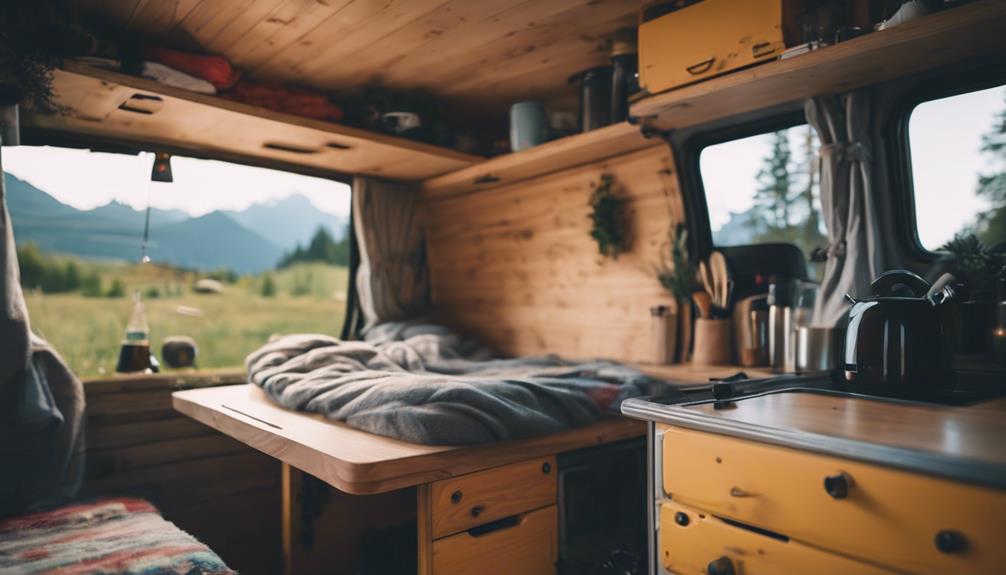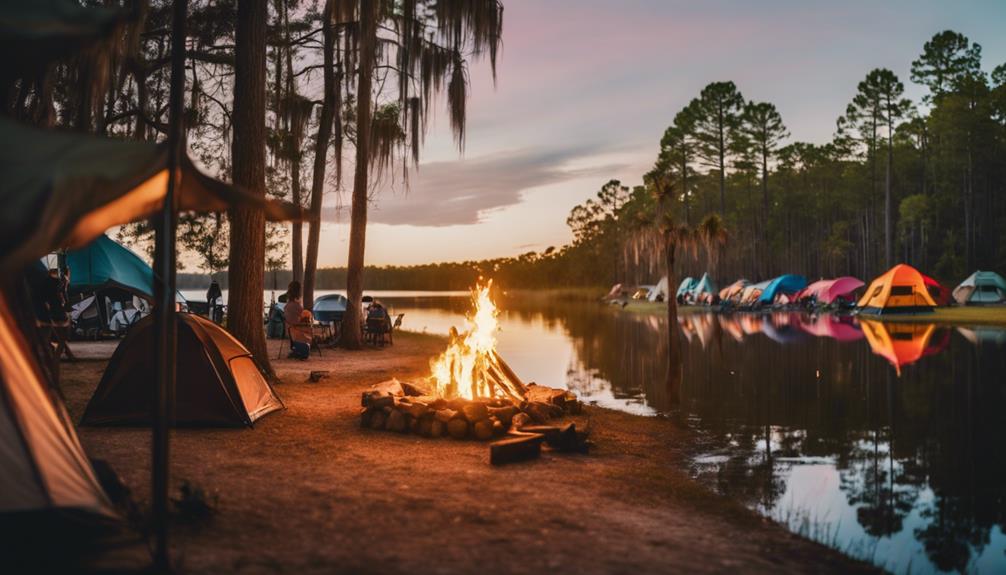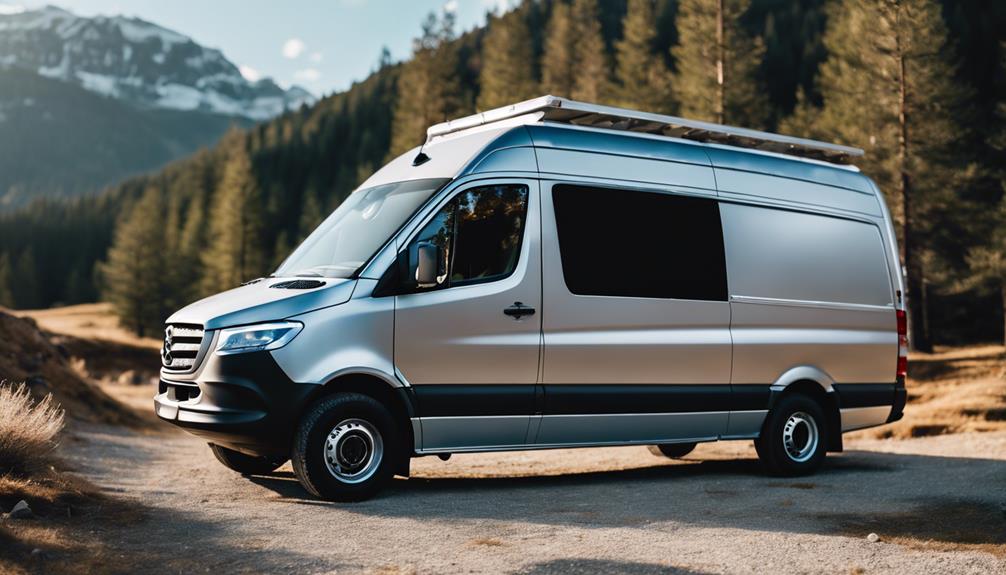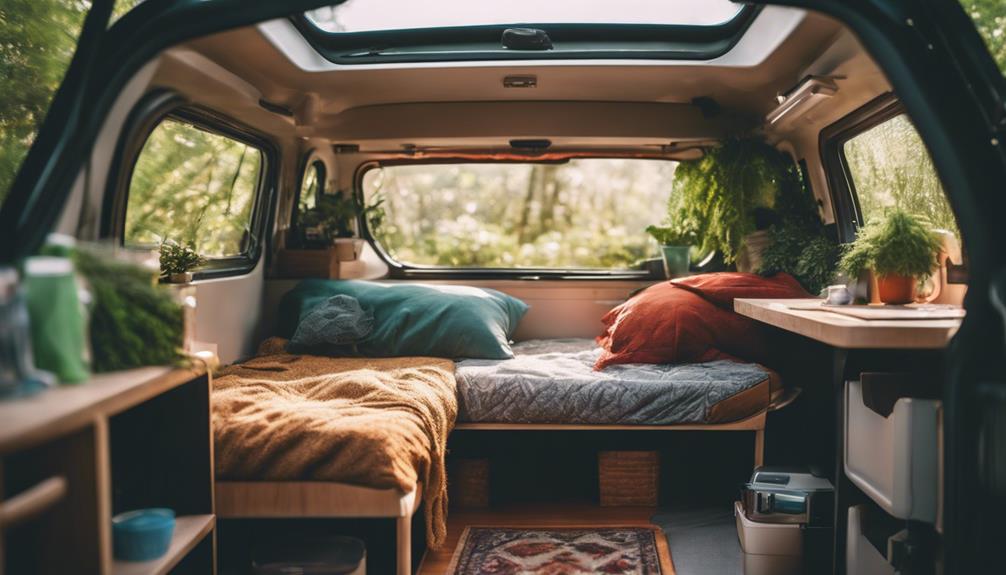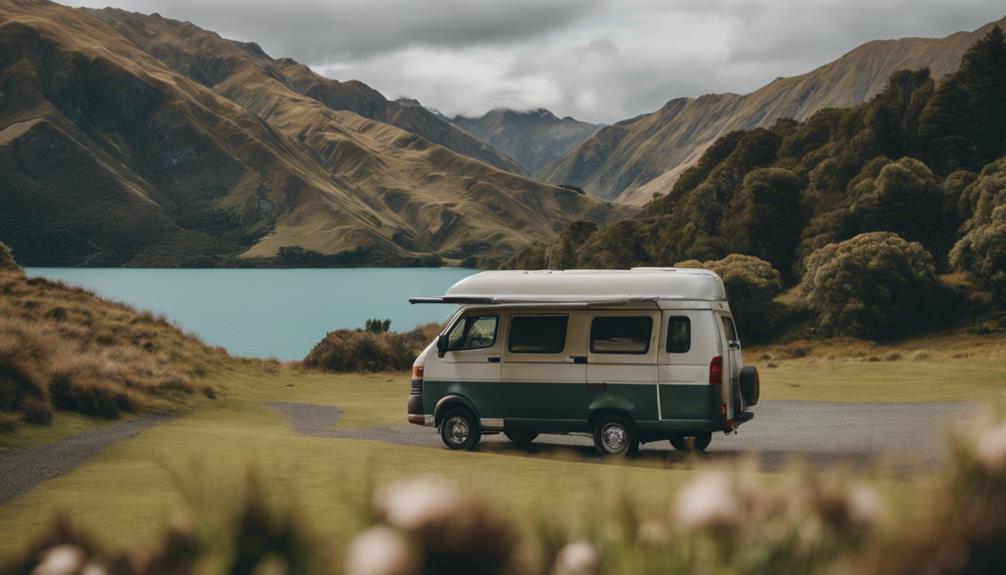Camper conversion is the process of transforming a standard vehicle, like a van, into a personalized living space designed for your travel needs. You can choose to do it yourself for a hands-on experience or hire professionals if you prefer. The transformation involves careful planning to optimize space for sleeping, cooking, and storage while incorporating features like insulation, electrical systems, and water supply. As you customize your camper, consider using eco-friendly materials and innovative designs for efficiency. There's much more to uncover about materials, tools, and trends to help you create the perfect mobile living area.
Introduction
Camper conversion transforms a van into your personal living space, tailored to fit your unique needs and lifestyle. Whether you're dreaming of the freedom of van life or seeking a practical getaway option, understanding the camper conversion process is key. You can choose between DIY campervan conversions or hiring professionals, depending on your skills and budget.
Start by planning the layout to maximize your space. Think about where you'll sleep, cook, and store your belongings. Once you've got a plan, you'll need to decide on insulation options to keep your van comfortable in various climates.
An efficient water system is essential for cooking and cleaning, so consider your needs carefully. Don't overlook the importance of an electrical system, as it powers your lights, appliances, and devices.
Throughout this journey, community support can be invaluable; tapping into online forums and guides helps you navigate challenges and share tips with fellow enthusiasts. Armed with this knowledge, you're ready to begin your camper conversion adventure, creating a mobile haven that reflects who you are and how you want to live.
Background Information
Campervan culture has roots in the desire for adventure and freedom, sparking a movement that's grown over the decades.
You'll also notice that design innovations have transformed these vehicles into comfortable, functional homes on wheels.
Understanding these origins and advancements is key to appreciating the camper conversion process.
Campervan Culture Origins
Emerging in the early 20th century, the culture around van living evolved from the growing popularity of automobile travel and the need for mobile accommodations during road trips.
The introduction of the Volkswagen Type 2 Microbus in the 1950s played a significant role, symbolizing freedom and adventure for those enthusiastic to explore. This vehicle became a canvas for many, inspiring the DIY campervan movement that surged in the 1960s and 70s, often associated with counterculture and the hippie movement.
During this time, people embraced alternative lifestyles, seeking nomadic living as a way to break free from conventional norms. The internet's rise in the 1990s further fueled this passion, allowing enthusiasts to share ideas and experiences, creating a global community centered around campervan culture.
Today, this culture emphasizes minimalism, travel freedom, and a strong desire for self-sufficiency. Many van lifers prioritize sustainability, adopting eco-friendly practices as they navigate their adventures.
Campervan Design Innovations
Innovations in design are transforming how people live and travel in vans, making the most of limited space while enhancing comfort and functionality.
Campervan design innovations focus on maximizing space efficiency through multifunctional furniture, like foldable tables and convertible seating, which optimize your living area. Advances in insulation materials, such as Thinsulate and Low-E insulation, improve thermal performance without adding excessive weight, ensuring better climate control in your campervan.
The integration of solar power systems has revolutionized campervan designs, enabling off-grid living with the ability to power essential appliances, like fridges and lights, using solar panels. This means you can enjoy the freedom of traveling without being tied to a power source.
Additionally, smart technology plays a significant role in modern camper conversions, featuring app-controlled lighting and heating systems that enhance both comfort and usability.
Innovative storage solutions, including overhead cabin storage and under-bed compartments, are vital for improving organization and accessibility within compact living spaces.
With these advancements, you can create a functional, comfortable, and efficient home on wheels that meets all your travel needs.
Recent Design Innovations
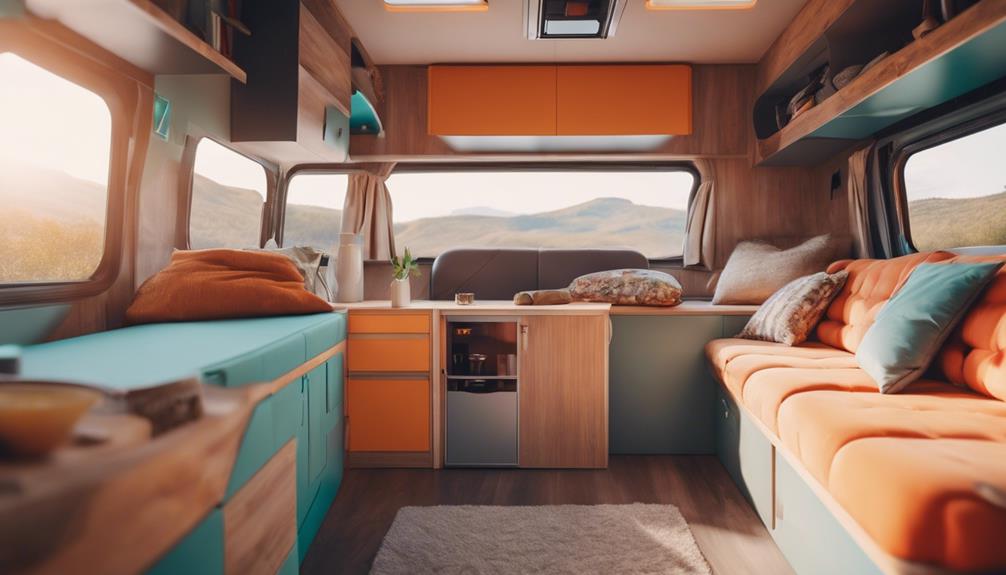
Recent design innovations in camper conversions are transforming how you think about space and sustainability.
You'll find that sustainable materials and innovative modular furniture designs not only enhance aesthetics but also maximize functionality.
These advancements make it easier for you to create a comfortable and eco-friendly living environment on the road.
Sustainable Materials in Designs
Sustainable materials like bamboo, reclaimed wood, and recycled metals are transforming campervan designs, offering both environmental benefits and unique aesthetic appeal. By choosing these sustainable materials, you not only reduce your carbon footprint but also create a cozy, inviting space that stands out.
Eco-friendly insulation options such as sheep's wool and recycled denim provide excellent thermal performance, ensuring you stay comfortable while minimizing environmental impact.
Incorporating low-VOC paints and finishes is another essential step. These products help improve indoor air quality and promote a healthier living environment.
Plus, integrating solar panels and energy-efficient appliances allows you to harness renewable energy, making your campervan more self-sufficient and reducing reliance on fossil fuels.
Water-saving fixtures like low-flow faucets and composting toilets further enhance your camper's sustainability. These innovations conserve precious water resources during your travels, allowing you to enjoy the great outdoors without feeling guilty about your environmental impact.
Innovative Modular Furniture Designs
Modular furniture designs are revolutionizing campervans by offering multifunctional pieces that adapt to your changing needs, like beds that easily convert into seating or storage. These innovative designs emphasize lightweight materials, ensuring easy installation and flexibility in layout. You'll appreciate how modular furniture maximizes your limited space, fitting seamlessly with various activities, from sleeping to dining or working.
Recent advancements incorporate collapsible or foldable elements that enhance the versatility of your living area. With adjustable shelving and tailored storage solutions, you can create customizable configurations that cater to your personal preferences. This means you can easily rearrange your setup based on your daily activities or travel plans.
Eco-friendly options are gaining popularity, with materials like bamboo and recycled composites making their way into these designs. Not only are these materials durable, but they also add an aesthetic appeal that enhances your camper's interior. By choosing modular furniture, you're investing in a practical, sustainable solution that elevates your camping experience and allows you to enjoy both comfort and style on the road.
Expert Insights on Trends
As you explore the camper conversion world, it's essential to weigh the benefits and drawbacks of different approaches.
We'll share insights from industry experts and compare various vans to help you make an informed decision.
Understanding these trends can guide your conversion journey, ensuring it fits your lifestyle and budget.
Benefits and Drawbacks
Campervan conversions offer a unique blend of flexibility and adventure, allowing you to customize your living space while embracing the freedom of the open road.
One of the biggest benefits is the ability to tailor your camper to suit your specific needs, whether you prioritize work, storage, or travel style. The trend of DIY campervan conversions has gained popularity due to potential cost savings, with projects ranging from £3,000 to £10,000 depending on complexity.
However, there are drawbacks to take into account. The time investment for planning and executing a conversion can be significant, often taking months or even over a year to complete. Plus, you'll need to navigate legal requirements, ensuring your camper meets safety standards and securing appropriate insurance to avoid future liabilities.
Ultimately, while customizing a campervan can enhance your adventures and provide unparalleled flexibility, it's important to weigh these benefits against the potential challenges. By carefully planning your conversion and addressing any legal considerations upfront, you can enjoy the best of both worlds: a personalized living space and the freedom to explore.
Industry Expert Interviews
Industry experts are witnessing a surge in DIY campervan conversions, driven by a desire for personalized travel experiences and the appeal of self-building. This trend highlights the growing interest in customizing spaces, enabling you to create a home on wheels that reflects your unique style. Many enthusiasts are opting for eco-friendly materials, incorporating sustainable practices that align with their values.
Experts stress the importance of a detailed guide when starting on your DIY campervan conversion journey. With advancements in technology, solar power systems are becoming more accessible, allowing for energy-efficient designs that maximize your camper's potential. Proper campervan insulation is also essential, guaranteeing comfort and energy efficiency during your travels.
Community engagement plays an important role in this movement. Online platforms and social media provide spaces for sharing tips, inspiration, and troubleshooting advice, connecting you with fellow enthusiasts.
However, it's important to stay informed about legal regulations and safety standards that affect your conversion. Adhering to these guidelines not only secures your safety but also impacts your camper's resale value and insurance options.
Embrace this exciting journey and create your perfect getaway!
Feature Comparison of Vans
When choosing the right van for your conversion, understanding the unique features and benefits of each model can greatly impact your DIY experience.
The Volkswagen Transporter stands out with its iconic design, ease of maintenance, and strong resale value, making it a favorite among van lifers.
If you're looking for adaptability, the Ford Transit offers various wheel lengths and roof heights, allowing for diverse conversion layouts tailored to different lifestyles.
The Fiat Ducato is another excellent option, known for its spacious interior and cost-effectiveness, providing plenty of room for essential features while remaining budget-friendly for those looking to convert a campervan.
Meanwhile, the Mercedes Sprinter is highly sought after in the second-hand market due to its versatility and durability, suitable for both personal and commercial uses.
In recent trends, mid-size vans like the Renault Trafic have gained popularity, striking a balance between reliability and interior space. This makes them ideal for those seeking practical yet compact options for their DIY camper van conversion.
Ultimately, each van offers unique advantages, so consider what features matter most to you when making your choice.
Essential Tools for Conversion
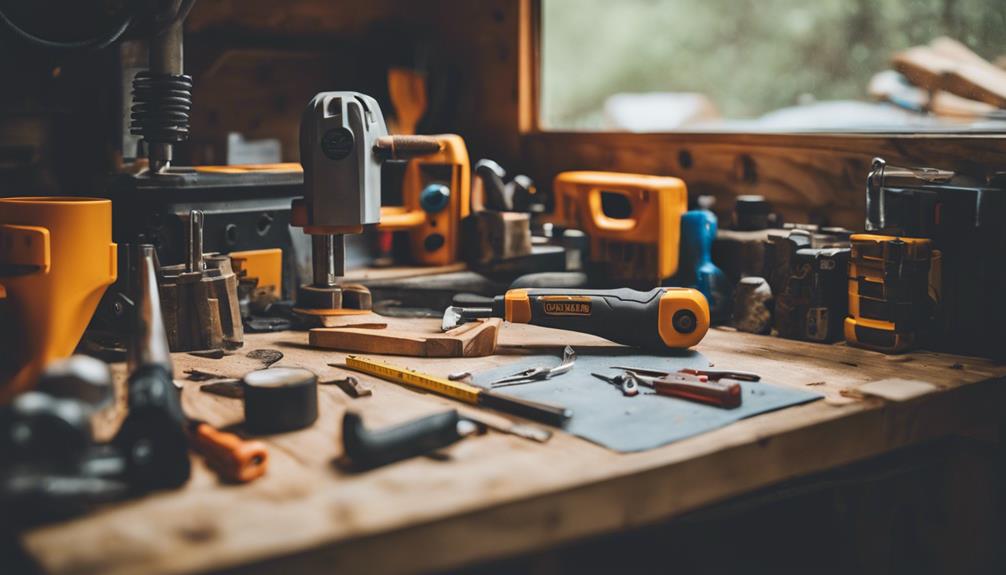
When you're tackling a camper conversion, having the right tools is key to a smooth and efficient process.
You'll need essentials like a circular saw, drill, and jigsaw for accurate cuts and assembly.
Don't forget about safety precautions—protecting yourself with gear like goggles and gloves will keep you safe while you work.
Detailed Conversion Process
To successfully convert your campervan, you'll need a set of essential tools that guarantee precision and safety throughout the process.
Start with a power drill to secure components effectively. A jigsaw is important for cutting wood and insulation to fit your design, while a level guarantees surfaces are even, making your conversion look professional.
For framing, a circular or miter saw will help you accurately cut materials for beds and cabinets, maximizing your storage space. When it comes to the electrical system, a multimeter is essential for testing connections and verifying the proper voltage, especially when installing solar panels and batteries.
Don't forget to gather safety gear like gloves, goggles, and a dust mask to protect yourself from injuries and dust while working.
Depending on the complexity of your project, specialized tools such as a crimping tool for making electrical connections and a rivet gun for securing metal components might also be necessary.
With these tools in hand, you'll be well-equipped to tackle your campervan conversion with confidence and skill.
Safety Precautions During Conversion
Guaranteeing safety during your campervan conversion is crucial, as it protects you from injuries and enhances the overall efficiency of your project. Start by equipping yourself with proper safety gear—wear durable gloves, goggles, and a dust mask to shield yourself from dust and debris. These precautions help prevent respiratory issues and protect your eyes and hands during the conversion process.
Next, gather essential tools like a circular saw for cutting wood, a drill for assembling components, and a level to maintain the structural integrity of your installations. Accurate measurements are critical, so invest in a quality measuring tape and square to guarantee precise cuts that fit your van's confined space.
A multi-tool can assist with quick fixes, while a torque wrench ensures screws and bolts are tightened correctly, avoiding future complications. A thorough tool kit, including wrenches, pliers, and screwdrivers, will streamline your conversion process.
With the right safety gear and tools at your disposal, you'll work more confidently and efficiently, making your campervan conversion project a safer and more enjoyable experience.
Is Registering a Camper Conversion Necessary for a Comprehensive Guide on Camper Conversions?
Registering a camper conversion is necessary for a comprehensive guide on camper conversions. Understanding the legal requirements and documentation needed to register a camper conversion is crucial for ensuring compliance and peace of mind while traveling. Knowing how to register a camper conversion will help you avoid potential issues down the road.
What Are the Steps Involved in Camper Conversion?
When embarking on a camper conversion, gathering the necessary supplies for camper conversion is the first step. This may include insulation, flooring, electrical components, and interior fixtures. Planning the layout and design, sourcing materials, and executing the conversion are all essential steps in the process.
Conclusion
Converting a campervan can be a rewarding journey that transforms your travel experiences into comfortable adventures. By carefully planning your campervan conversion, you'll ascertain you choose the right van and create a space that meets your needs.
Whether you're diving into DIY conversions or hiring professionals, understanding the essentials like insulation and electrical setup will greatly enhance your comfort and functionality on the road.
Don't overlook legal considerations, as reclassifying your vehicle and securing proper insurance are vital steps to protect your investment.
Successful conversion relies on thorough research and attention to detail; each element from layout to materials affects your overall experience.
Frequently Asked Questions
What Is the Best Campervan Conversion Guide?
You'll find the best campervan conversion guide by exploring options that detail planning, tools, and legal requirements. Look for one that shares community insights and practical tips to enhance your conversion experience effectively.
What Order to Do Camper Conversion?
When converting your camper, start with planning your layout and budget. Next, strip the interior, install insulation, then set up electrical and plumbing systems. Finally, add exterior features and furnish the interior for comfort.
How Much Does a Camper Conversion Cost?
A camper conversion can cost you anywhere from under £1,000 to over £10,000, depending on your choices. By managing your budget and researching similar projects, you can set realistic expectations and avoid surprises.
Do Converted Campervans Hold Their Value?
Yes, converted campervans hold their value well, especially popular models. High-quality conversions with desirable features can sell for considerably more than unconverted vans, particularly during peak seasons when demand for recreational vehicles surges.
Conclusion
To sum up, camper conversion opens up a world of adventure and freedom for you.
By understanding the essentials and keeping up with the latest trends, you can create a personalized space that meets your needs.
With the right tools and a bit of creativity, you'll transform a simple vehicle into your dream getaway.
So, don't hesitate—dive into the camper conversion journey and start crafting unforgettable experiences on the road!

